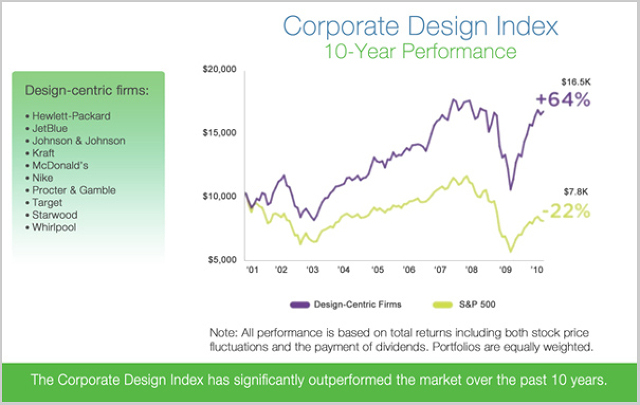Integrating design into your company involves more than just hiring superstar designers. It takes a long-term commitment and developing a culture that brings everyone up to speed, writes motives Jeneanne Rae.
While design has always been fundamental to industries such as fashion and consumer electronics, it has now spread to nontraditional settings such as airlines, consumer goods, and even governments, where it has become the driver for differentiated end-to-end customer experiences as well as innovation. That's no longer news: Today, most executives recognize that design can be a source of competitive advantage. What most executives don't recognize is how to manage design strategically, how to use it to win in their industry, and how high-performance design organizations are organized to deliver great results. After years of leading assessment and change management efforts at global corporations, here's what I've figured out that leaders need to know to start to build design into the DNA of their organisations.

ALIGN GOALS AND STRATEGY. The most effective design organizations set goals that are aligned with their organization's corporate strategy. When HP went on a recent cost-cutting spree, its design team heroically delivered more than $50 million a year in savings by standardizing of the HP "jewel" logo across its vast array of equipment. Having a clear design vision and strategy like this allows a design organization to know what it is shooting for and to put in place the appropriate talent and other resources to execute the plan. However, getting the vision and strategy to align with the talent and resources required to execute is most often where things go awry. In nascent situations, neither the design executives nor the executive leadership team understand the extent of the organizational development effort required to support the corporate strategy. Consequently, progress is often slow and more painful than it needs to be. Simple tools like organizational road mapping and the resourcing to support the plan can set the right course for transformation, yet I've seen few companies treat design capability building seriously enough to merit this type of attention. Why? UNDERSTAND
THE DIFFERENCE BETWEEN DESIGN THINKING AND DESIGN. Much has been made of using design methods (commonly referred to as "design thinking") for solving complex business challenges. In fact, the term has gotten so much coverage lately that I fear that many people are starting to think about design and design thinking as interchangeable terms. They are not. Design thinking is methodology that is taught in certain types of design schools, notably industrial design and architecture; therefore only a subset of all designers are bona fide design thinkers through their academic training and practice. While better use of design thinking methods should be useful for any corporation in solving its most wicked problems, design thinking will not in and of itself drive better design.
HIRING SUPERSTAR DESIGNERS IS NOT THE ANSWER. A common theme that we've observed over the last several years is that senior executives who are hot on pursuing design as a business strategy coerce a seasoned design star into their companies only to find themselves frustrated 12 to 18 months out when they haven't become the "Apple of their industry." Worse is when corporations go through the time, expense, and trouble to hire multiple superstar designers only to have them leave within a short period after becoming frustrated by the system and lack of results they are able to produce. Not only does this situation beget very low returns on substantial investments but also significant product disruptions and low morale for the people left behind. While getting the best talent is an important goal, creating an environment where design can thrive should be the greater focus.
MEASURING THE RETURN ON INVESTMENT FOR DESIGN IS A LONG-TERM PURSUIT. Skeptics always want to know why they should make such significant investments in design. Unfortunately, this is a difficult question to answer. Companies such as Nielsen that analyze marketing-mix investments do not account for design. The impact of design can span a variety of activities. And measuring emotional impact, or the "delight factor," of design is poorly understood in corporations that do not invest heavily in studying why people choose or don't choose their products. However, if stock price can be viewed as a proxy for the impact of design in the marketplace, consider the performance of this bucket of 10 firms that have invested significantly in design over the last 10 years. Using an approach similar to how performance of the S&P 500 is derived, our analysis shows that a $10,000 investment in our design index of diverse design-centric companies would have yielded a 64% return, whereas an investment in the S&P would have yielded a -22% return. The outsized returns for design-centric organizations represent a collective set of design investments on the part of each firm, as no single investment could possibly drive the type of momentum realized. Note: To normalize data, we left Apple off the list.
GREAT DESIGN LEADERSHIP IS IMPORTANT. BUT GREAT CHANGE MANAGEMENT IS
EVEN MORE IMPORTANT. It is true that most high-performance corporate design functions have seasoned leaders who possess what it takes to make the "magic" happen for a multibillion-dollar global enterprise. What is less known but also true is that a hallmark of design-centric companies is that design seamlessly integrates into the larger set of processes that constitute production in their organizations. Whether the process is budgeting, innovation, engineering development, branding, supply chain management, or something else, design has an uncontested role and decision rights. Mature organizations aspiring to use design strategically will find this state of nirvana elusive without significant intervention. Overhauling processes is painful; managers despise having their former roles usurped; design culture and training leave managers unprepared for such organizational wrestling. Further, such far-reaching change cannot solely be design's job. Any company that wants more and better design must mandate that design be embraced. But as Chuck Jones, a former VP of design at Whirlpool and now chief design officer at Masco Corporation, says, that requires a long-term commitment: "You have to be in it for the long haul: Creating sustainable competitive advantage through design is not a quick or easy task. In my view, it will take seven to 10 years to get the capability to a point where it is consistently producing the kinds of results that are winning in the marketplace with the added benefit of shifting the relevant brand image to that of 'design leader.' From there, it is up to the entire organization to maintain this commitment and focus on design--for decades. Herman Miller, as an example, comes to mind. Their focus on design leadership spans over 60 years and continues unabated." Organizations that do this quicker than most employ a range of internal help, not the least of which is a senior leadership team whose unwavering support ensures the organization enacts the required change.
COMPANIES THAT GET THE MOST FROM DESIGN RELY ON A CULTURE OF DESIGN. Any organization that wants to leverage design for strategic advantage needs to know that this cannot be achieved overnight; most likely, it will take many years. One way to shorten the journey is to concentrate some portion of the effort on building a culture of design. Achieving a culture of design means that everyone in the organization understands what design is, how it is used for strategic advantage in the organization, how and when design resources are used, what the work of design entails, and how design efforts should integrate with the company's production processes. "It's been extremely important to share with the organization that design was beyond pretty products and cake decoration at the end of the innovation process," says Mauro Porcini, 3M's head of global strategic design. "We made clear in all possible ways that by definition design was not just about designers: We wanted to have each 3M function, from marketing to the laboratories, from manufacturing to sourcing, from HR to legal, aware of the value of design, engaged, eventually excited, and ready to drive the design strategy as a collective collaborative effort." Along with championing the design process, the best corporate design leaders are effective at conveying design's importance to the health of the enterprise, especially in the early days of their tenure. In an organization the size of Procter & Gamble, Coca-Cola, 3M, Masco, Johnson & Johnson, or Hewlett-Packard, where remarkable design transformations are presently under way, this can be a difficult task. Nevertheless, individual and collective efforts like those mentioned here are making a difference every day in turning these admired companies into the design leaders of the future.
CHECKLIST: FIVE TIPS FOR BUILDING CORPORATE DESIGN ORGANIZATIONS Consistently great corporate design is the product of the following elements: 1. A vision and strategy that is well-articulated and understood by its organization; 2. leadership that is capable and committed to driving its vision; 3. an organization that is structured and resourced for success; 4. a talent pool that is diverse in design disciplines and deployed at key points of functional integration; 5. a culture that embraces the myriad dimensions of design.

Jeneanne Rae is the CEO of Motiv Strategies, and is an internationally recognized thought leader on innovation management and design strategy.
Original article via fastcodesign.com